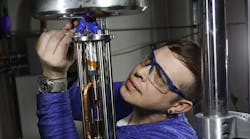National Labs Explore Hydrogen and its Reactions with Metals and Polymers
The United States produces about 10 million metric tons of hydrogen every year, primarily for refining petroleum and making ammonia. But the use of hydrogen is growing in the transportation field where thousands of fuel cells power forklifts and other vehicles, which someday may include cars and trucks. Other uses for hydrogen are emerging as innovations find use for it in refining iron and storing energy.
A common problem for industries that use hydrogen is that the metal structures that store or transfer it—such as valves, pumps, fuel tanks, and storage vessels—must be made of expensive alloys of aluminum and steel. Hydrogen damages these alloys given enough exposure. To avoid unexpected failures, metal components exposed to hydrogen are routinely inspected and taken out of service after a set number of years. But the actual mechanisms of interactions between hydrogen and metals at the nano and microscale levels are not well understood, so component lifetimes are challenging to estimate. Even less is known about how hydrogen affects polymers, which ae used in plastic pipes and rubber seals that get exposed to hydrogen.
To get a better understanding of how hydrogen reacts with materials, researchers at Sandia and Pacific Northwest national laboratories will work together in the Hydrogen Materials Compatibility Consortium (H-Mat). It will focus on how hydrogen affects polymers and metals used in various industrial sectors, including fuel-cell transportation and hydrogen infrastructure. Researchers at Oak Ridge, Savannah River, and Argonne national laboratories, as well as in industry and academia, will also be included in the consortium. The effort supports DoE’s H2@Scale initiative, which aims to advance hydrogen use for energy production and storage as well as industrial processes.
Hydrogen affects metals through a class of interactions called hydrogen embrittlement. Hydrogen embrittlement and hydrogen-induced cracking in metals can be visible. But they start at the microscopic level, and little is known about the effects of hydrogen there. Far less is known about how hydrogen affects polymers. In these materials, hydrogen forms pressurized gas bubbles that concentrate stress and lead to damage. There is growing evidence that hydrogen also interacts with polymers at the atomic scale, which may accelerate degradation.
Up until now, much of what is known about hydrogen has been based on R&D at the national labs to characterize metals and polymers in high-pressure hydrogen environments. The H-Mat consortium will dig deeper into the underlying science of hydrogen’s behavior using imaging and surface characterization techniques to study hydrogen interactions with materials at sizes ranging from the atomic to the engineering scale. Researchers will also be developing computer models to predict the mechanisms of these interactions and how hydrogen-induced damage starts and then grows. Those predictions will help material engineers tailor the compositional and microstructural makeup of materials to withstand hydrogen-induced damage.
Researchers at Sandia will study the behavior of metals and polymers exposed to high-pressure hydrogen environments using high-tech equipment at the Livermore campus, while the team at Pacific Northwest National Lab carries out characterization and experimental studies of cracking and degradation in polymers.
“The advanced computational capabilities, unique experimental facilities and scientific expertise at the national labs will improve our understanding of the interaction between hydrogen gas and polymers and metals,” says Chris San Marchi, Sandia materials scientist and co-lead for the consortium. “The goal is to improve materials reliability in hydrogen infrastructure for large scale use of hydrogen as an energy carrier.”

